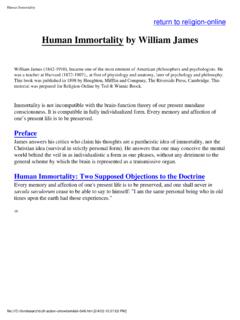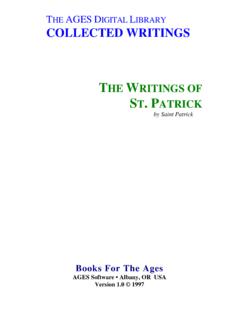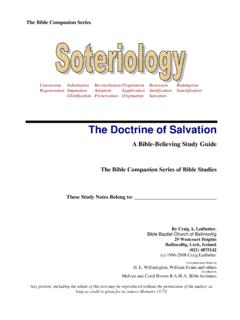Transcription of Christian Theology - SABDA.org
1 Christian Theology Millard J. Erickson BAKER BOOK HOUSE DD. Grand Rapids, Michigan 49506 DD. lb Bernard Ramm, my first Theology professor;. William E. Hordern, my doctoral mentor;. and Wolfhart Pannenberg, whose theological scholarship has been an inspiration to me Copyright 1983, 1984, 1985 b y Baker Book House Company ISBN: o-8010-3433-7. Library of Congress Catalog Card Number: 83-071868. Originally published as three volumes: Vol. 1 (Parts l-4), 1983; Vol. 2 (Parts 5-8), 1984; Vol. 3 (Parts 9-12), 1985. Seventh printing, April 1990. Contents Preface 9. PARTONE Studying God 1. What Is Theology ? 17 4. Theology and Critical Study The Nature of Religion 17 of the Bible 81. The Definition of Theology 21 Form Criticism 84. Locating (Systematic) Theology Redaction Criticism 95. on the Theological Map 22 Guidelines for Evaluating Critical The Need for Theology 28 Methods 102.
2 The Starting Point of Theology 30. Theology as Science 33 5. Contemporizing the Christian Why the Bible? 36 Message 105. The Challenge of Obsolescence 105. 2. Theology and Philosophy 39 The Locus of Permanence in Types of Relationships Between Christianity 107. Theology and Philosophy 40 TWO Approaches to Contemporizing Some Twentieth-Century Theology 112. Philosophies 42 Criteria of Permanence 120. Theology 's Use of Philosophy 53. 6. Theology and Its Language 127. 3. The Method of Theology 59 Theological Language and Verificational The Theological Scene Today 59 Analysis: The Accusation of Meaninglessness 128. The Process of Doing Theology 66. Theological Language and Functional Degrees of Authority of Theological Analysis 133. Statements 79. Answers to the Accusation of Meaninglessness 135.
3 1. 2 Contents Contents 3. PARTTWO Knowing God PARTFOUR What God Does 7. God's Universal Revelation 153 The Extent of Inspiration 210 16. God's Plan 345 18. God's Continuing Work: The Nature of Revelation 153 The Intensiveness of Inspiration 212 Key Definitions 345 Providence 387. The Loci of General Revelation 154 A Model of Inspiration 214 The biblical Teaching 347 Providence as Preservation 388. The Reality and Efficacy of General The Nature of the Divine Plan 351 Providence as Government 394. Revelation 156 Logical Priority: God's Plan or Providence and Prayer 405. General Revelation and Human 10. The Dependability of God's Word: Human Action? 355 Providence and Miracles 406. Responsibility 171 Inerrancy 221 A Moderately Calvinistic Model 356. Implications of General Revelation 173 Various Conceptions of Inerrancy 222 Various Understandings of History 362.
4 The Importance of Inerrancy 225. Inerrancy and Phenomena 229 17. God's Originating Work: 19. Evil and God's World: 8. God's Particular Revelation 175 Defining Inerrancy 233 Creation A Special Problem 411. The Definition and Necessity of Ancillary Issues 238 Reasons for Studying the Doctrine of The Nature of the Problem 411. Special Revelation 175 Creation 366 l)pes of Solutions 413. The Style of Special Revelation 177 Elements of the biblical Teaching on Themes for Dealing with the Problem The Modes of Special Revelation 181 11. The Power of God's Word: Creation 367 of Evil 423. Special Revelation: Propositional Authority 241 God's Later Creative Work 373. or Personal? 191 The Theological Meaning of Definition of Authority 242 the Doctrine 374. Scripture as Revelation 196. Religious Authority 244 The Creation Doctrine and Its Relation 20.
5 God's Special Agents: Angels 433. Establishing the Meaning and Divine to Science 378. 1. Origin of the Bible 246 History of the Doctrine 434. 9. The Preservation of the The Uniqueness of God's Creative The Internal Working of the Holy Work 384 Good Angels 437. Revelation: Inspiration 199 Spirit 247 Evil Angels 445. Implications of the Doctrine of Definition of Inspiration 199 Objective and Subjective Components Creation 385 The Role of the Doctrine of Angels 451. The Fact of Inspiration 200 of Authority 251. Issues in Formulating a Theory Various Views of Illumination 253. of Inspiration 203 The Bible, Reason, and the Spirit 256. Theories of Inspiration 206 Tradition and Authority 258. PART FIVE Humanity The Method of Formulating a Theory Historical and Normative of Inspiration 207 Authoritativeness 258.
6 21. Introduction to the Doctrine of Conclusions Regarding the Nature Humanity 455 of the Image 512. Implications of the Doctrine 515. Importance of the Doctrine of Humanity 455 24. The Constitutional Nature FART MREE What God IS Like Images of Man 462 of the Human 519. The Christian View of Man 470. Basic Views of the Human Constitution 520. 12. The Greatness of God 263 14. God's Nearness and Distance: 22. The Origin of Humanity 473. biblical Considerations 527. Immanence and The Meaning of Origin 473 Philosophical Considerations 530. The Nature of Attributes 265 Transcendence 301 The Status of Adam and Eve 474 An Alternative Model: Classifications of Attributes 266. Immanence 302 Views of Human Beginning 477 Conditional Unity 536. Attributes of Greatness 267. nanscendence 3 12 The Age of Man 484 Implications of Conditional Unity 538.
7 The Theological Meaning of 15. God's Three-in-Oneness: Human Creation 487 25. The Universality of Humanity 541. 13. The Goodness of God 283 The Trinity 321 All Races 542. 23. The Image of God in the Both Sexes 545. Moral Qualities 283 The biblical Teaching 322. Human 495 People of All Economic Statuses 549. God's Love and Justice-A Point Historical Constructions 332. of Tension? 297 Essential Elements of a Doctrine The Relevant Scripture Passages 496 The Aged 551. The Best Mode of Investigating God's of theTrinity 337 Views of the Image 498 The Unborn 553. Attributes 299 The Search for Analogies 338 Evaluation of the Views 510 The Unmarried 556. 4 Contents Contents 5. PART SIX Sin PART EIGHT The Work of Christ 26. The Nature of Sin 561 Effects on the Sinner 615 36. Introduction to the Work of The Basic Meaning of Atonement 811.
8 Effects on the Relationship Christ 761 Objections to the Penal-Substitution The Interrelationship Between the to Other Humans 618 Theory 815. Doctrine of Sin and Other The Functions of Christ 762. Doctrines 562 The Penal-Substitution Theory in The Stages of Christ's Work 769 Relation to the Other The Difficulty of Discussing Sin 563. Theories 8 19. Methods of Studying Sin 564 29. The Magnitude of Sin 621 37. Theories of the Atonement 781 The Implications of Substitutionary Terms for Sin 565 The Extent of Sin 621 The Significance of the Atonement 781 Atonement 822. The Essential Nature of Sin 577 The Intensiveness of Sin 625 The Manifold Theories of the Theories of Original Sin 631 Atonement 783. 27. The Source of Sin 581 Original Sin: A biblical and 39. The Extent of the Atonement 825. Various Conceptions of the Source Contemporary Model 636 38.
9 The Central Theme of Atonement 801 For Whom Did Christ Die? 825. of Sin 581. For What Did Christ Atone? 836. The biblical Teaching 596 Background Factors 802. Implications of the Various Views- 30. The Social Dimension of Sin 641 The New Testament Teaching 806. The Cure for Sin 599. The Difficulty of Recognizing Social Sin 642. 28. The Results of Sin 601 The biblical Teaching 643 PART NINE The Holy Spirit Results Affecting the Relationship Strategies for Overcoming with God 602 Social Sin 655. 40. The Person of the Holy Spirit 845 41. The Work of the Holy Spirit 865. The Importance of the Doctrine The Work of the Holy Spirit in the of the Holy Spirit 846 Old Testament 866. Difficulties in Understanding the The Work of the Holy Spirit in the Life PARTSEVEN The Person of Christ Holy Spirit 846 of Jesus 870.
10 The History of the Doctrine of the The Work of the Holy Spirit in the Life Holy Spirit 848 of the Christian 872. 31. Contemporary Issues in The Sinlessness of Jesus 718. The Nature of the Holy Spirit 857 The Miraculous Gifts Today 877. Christological Method 661 Implications of the Humanity of Jesus 721 Implications of the Doctrine Implications of the Work History and Christology 662 of the Holy Spirit 862 of the Spirit 882. The Person and the Work of Christ 675. Incarnation Viewed as Mythology 677. 34. The Unity of the Person of PART TEN Salvation Christ 723. 32. The Deity of Christ 683 The Importance and Difficulty 42. Conceptions 44. The Beginning of Salvation: of the Issue 723. The biblical Teaching 684 The biblical Material 724 of Salvation 887 Subjective Aspects 929. Historical Departures from Belief Early Misunderstandings 726 Effectual Calling 930.




